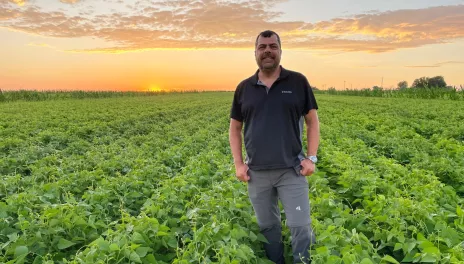NDSU’s dry bean breeding program seeks to impact global food security
Against the backdrop of a growing world population and evolving environmental conditions, strengthening food security is imperative for those involved in agriculture, particularly researchers and plant breeders.
More than 40% of dry beans produced in the U.S. come from North Dakota. The most prominently grown market classes in the state are pinto, navy, black, kidney, great northern, small red and pink beans.
Developing crop varieties adapted to drought, excessive heat and flooding, while maintaining resistance to diseases, is a challenge faced by the 12 plant breeding programs at North Dakota State University.
The dry bean breeding program led by Juan Osorno, NDSU professor of plant sciences and dry bean breeder, is one of those successful programs. The demand for dry beans is growing everywhere because of growing desire to eat healthier, plant-based proteins. Younger generations have become more interested in environmentally friendly food products as well. Breeding and releasing dry bean varieties that can adapt to various weather conditions and develop resistance to diseases while maintaining high productivity and good quality is a priority for Osorno and his team.
The dry bean breeding program started at NDSU in 1980 with Ken Grafton as the first breeder. Osorno is the second breeder, having taken over the program in 2007.
“The NDSU program is the youngest in the U.S. and has grown to be the largest dry bean public breeding program in the nation,” Osorno says. “Across those years, NDSU has developed and released more than 20 varieties across multiple market classes.”
The importance of breeding varieties comes down to one main goal: increasing seed yield while maintaining the desired quality and commercial characteristics required by the rest of the value chain actors in the industry. Osorno has worked with Phil McClean, NDSU plant sciences professor, during the breeding process, which includes incorporating advanced genomic tools into traditional breeding.
“Juan and I have worked closely together since he became the head of the dry bean breeding program here at NDSU,” McClean says. “My research group collaborates with Juan’s team to release new dry bean varieties of value to North Dakota and Minnesota dry bean producers. We have developed multiple genomic and genetic tools to identify the genetic factors associated with important traits such as disease resistance and adaptation to adverse climatic conditions. These tools include high-quality, reference-grade genomic sequences that are used to identify molecular marker tools that allow us to track specific traits throughout the selection process.”
A DNA diagnostic tool contains more than 4,000 markers for multiple traits that are essential for a new dry bean variety to be valuable to growers, McClean says.
There are many aspects to the genetic makeup of dry beans at play, including size, shape, color, canning/cooking capabilities and nutritional benefits.
“The most important are increasing yield/productivity, seed quality, disease resistance and tolerance, upright plant architecture, harvest maturity and some environmental stresses such as flooding and soil salinity tolerance,” Osorno says. “We use conventional genetics but also new tools like DNA technology, data science, genomics/bioinformatics and high-throughput phenotyping that includes drones and robots.”
Disease resistance is a priority in the breeding process as diseases can have a major role in reducing yields. These diseases include white mold, bean rust, anthracnose, common bacterial blight and fusarium.
“In each case, Juan’s group collected disease response data, and my group used molecular marker technology to genetically map factors associated with resistance to those diseases,” McClean says. “From that work, molecular markers were developed that can be used in Juan’s breeding program to select new genetic lines with resistance to these diseases.”
A new trait Osorno and McClean’s teams are working on is called “slow-darkening.” Beans darken as they are stored, which increases cooking time — something consumers consider undesirable.
They discovered that beans with the slow-darkening trait also have increased iron availability, which results in beans with improved nutritional value. Additionally, they cook faster than regular darkening pintos.
As the demand for dry beans grows in the consumer market, the importance of NDSU breeding program does as well, especially for growers in North Dakota and Minnesota.
“If we are more productive locally, thanks to improved varieties and other factors, we can have more beans available for both the domestic and international markets,” Osorno says.
In related news
Osorno awarded inaugural Jim Kirkeide Dry Bean Breeding Faculty Fellowship
